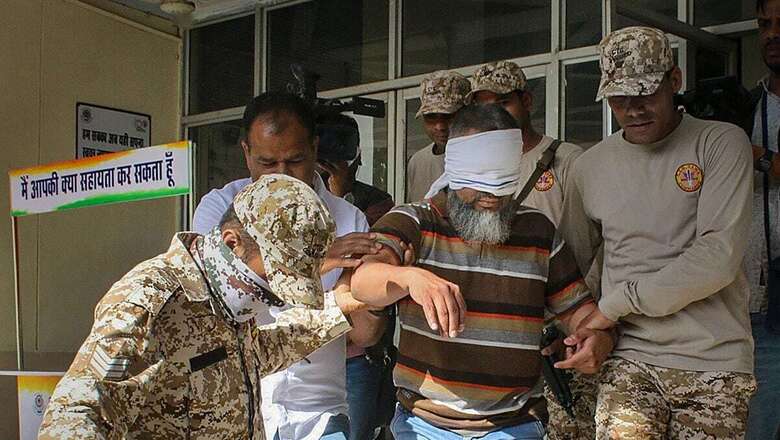
views
The Madhya Pradesh anti-terror squad and central agencies unearthed a new module of radicals, which has an uncanny resemblance with the ideology and modus operandi of the banned Popular Front of India (PFI). The group calls itself Hizb ut-Tahrir and its “ultimate goal” is “overthrowing democracy and establishing the Caliphate”.
A total of 16 people were arrested last week for allegedly conspiring to carry out an act of sabotage. The National Investigation Agency (NIA) could soon take over the investigation in the case due to links of this Bhopal group to Hyderabad and other parts of India. The MP government has formed a special investigation team (SIT) to look into terror links of the arrested suspects.
“The moot point about the group is its funding. We suspect the funds were coming in from outside the country, which a central agency can best investigate,” an officer said.
Police seized digital devices in which they reportedly found videos and literature about the workings of the Hizb ut-Tahrir (HuT). “They planned to implement their ultimate objective of establishing the Caliphate in four stages: motivate people to join the movement; make people owe allegiance to the HuT; carry out violent struggle; and establish the Caliphate. We have evidence to prove that they were working towards the third stage when arrested,” a Madhya Pradesh police officer told CNN-News18.
The PFI, too, in its 2047 “vision document” had stated a four-step goal to ultimately establish “Islamic rule” in India. “We have given ourselves a target of 2047 CE to bring about an Islamic government in this country,” the PFI document states.
According to the PFI document, the four stages of progression were: unite all Indian Muslims under the flag of the Popular Front of India; mass mobilisation under the leadership of PFI and use violence selectively to demonstrate PFI strength and terrorise opponents; win elections and fill all governance, judicial positions with PFI affiliates; and declare a new Constitution based on Islamic principles.
“The HuT cadre carried out a similar kind of physical and arms training as PFI,” said an official connected with the probe, adding, “special care was taken to cover their faces when training videos were recorded.”
Officials said this masking of identity was meant to protect suspects in case any link with the PFI was established. Use of apps like Threema, Rocket Chat, and the dark web for communication is also similar to the strategy used by other terror groups, police added.
Is the HuT the new PFI?
The HuT is a Middle East-based organisation founded in 1952 at Jerusalem. Its presence has been noted in Europe, Central Asia, Pakistan and Bangladesh. Its only known activity in India is a protest against Israel in Delhi’s Bata House area 13 years ago.
Officials further said HuT members in India earlier called themselves Tehreek-e-Khilafat. “We have been monitoring this group over the past two to three years,” an officer said, adding that since the HuT was active before the PFI was banned, it was unlikely that it was regrouping under a different name.
Intelligence agencies, however, are not ruling out the role of SIMI (Students’ Islamic Movement of India) sleeper cells, which aided the PFI as well. “The base cadre could be that of the SIMI, which was born in Madhya Pradesh and regrouped as the Indian Mujahideen (IM) after a ban, and also provided a cadre base to the PFI in several states,” an official told News18.
Religious conversion
Saleem, the alleged mastermind of the HuT arrested by the MP ATS, was originally called Saurabh Rajvaidya, who was born in a Jain family and converted to Islam in 2010. In 2012, his wife too converted to Islam. “Saleem is a PhD scholar from Berasia near Bhopal. He was teaching at the Deccan School of Pharmacy. We are investigating what motivated him to convert to Islam and then get radicalised,” a probe officer said.
Police said Yaseer, a gym instructor, is the other leader of the group. A resident of MP’s Shahjahanabad, he is also being probed for “forced religious conversion”. His wife also allegedly converted from Hinduism after marrying him.
Abdul Rehman alias Devi Prasad Panda from Odisha is the third suspect named by the ATS. Officials said he was a software engineer and scouting for a Hindu wife after conversion and even travelled to Bihar to marry. “It was strange that he had travelled to Bihar alone to look for a match. It was later revealed that the modus operandi is not to reveal conversion status and scout for possible matches within the Hindu community since you would not be viewed with suspicion,” an agency officer said.
Mohammad Abbas, a resident of Hyderabad, was Bux Venu Kumar before he embraced Islam, police said. Five women who allegedly converted after marriage to the suspects were yet to be interrogated.

















Comments
0 comment